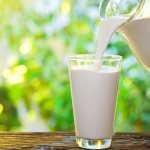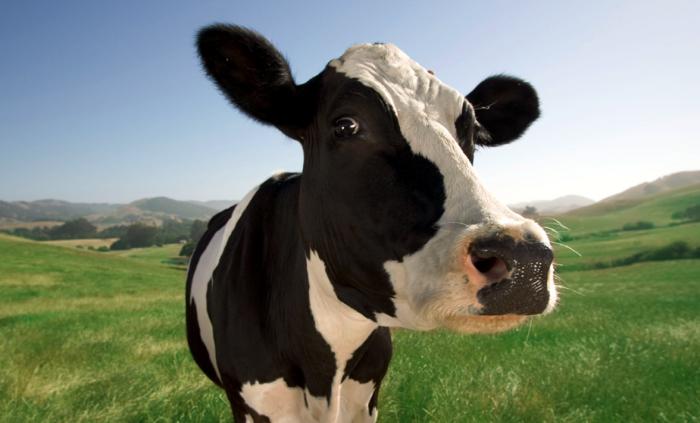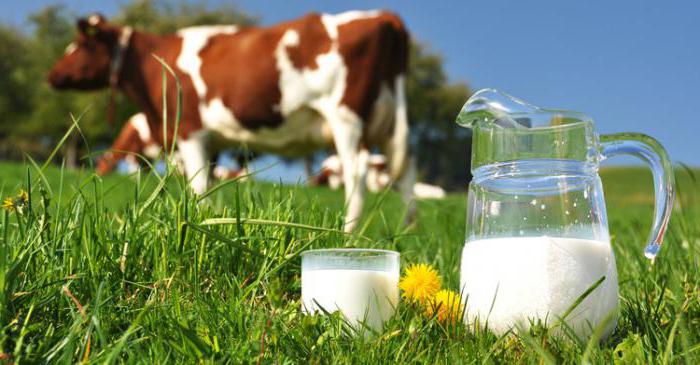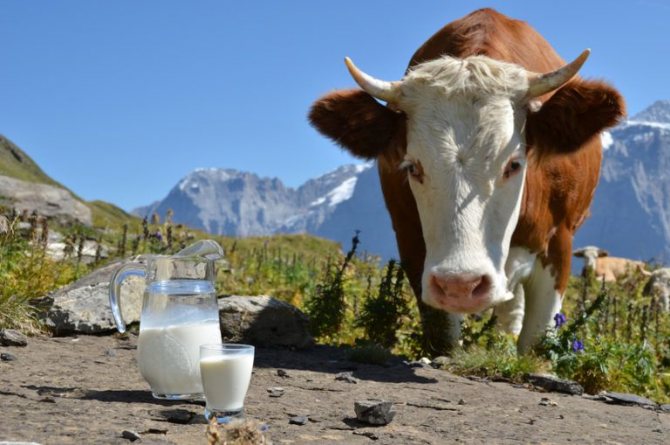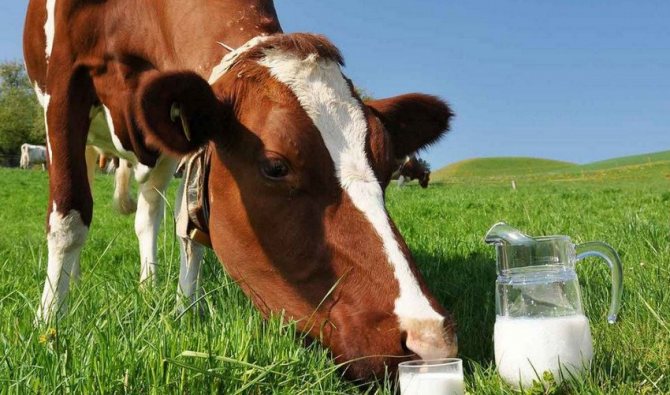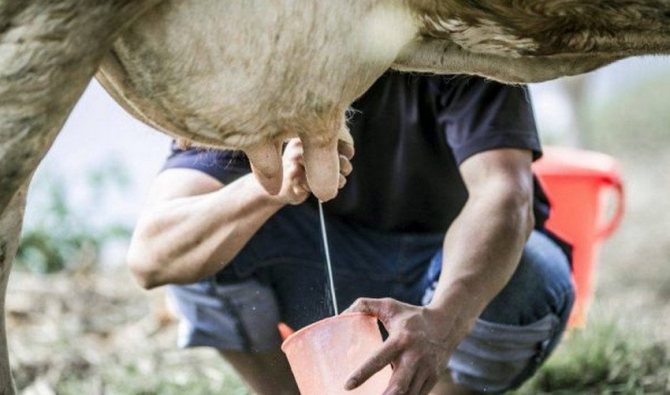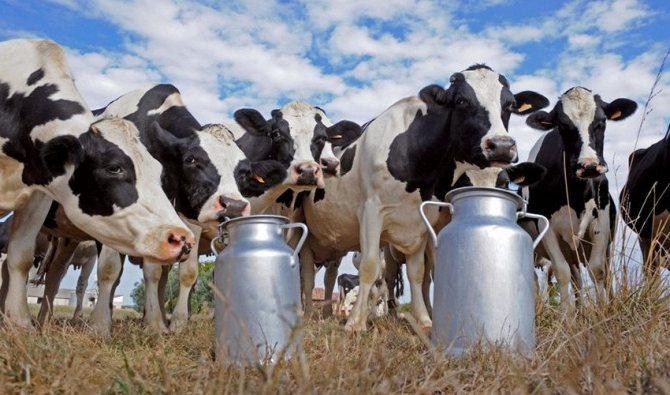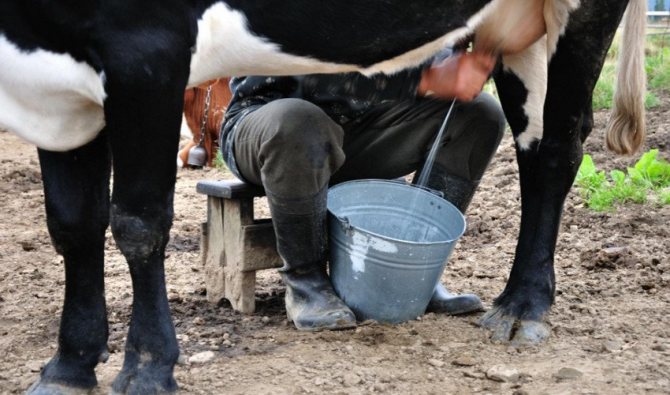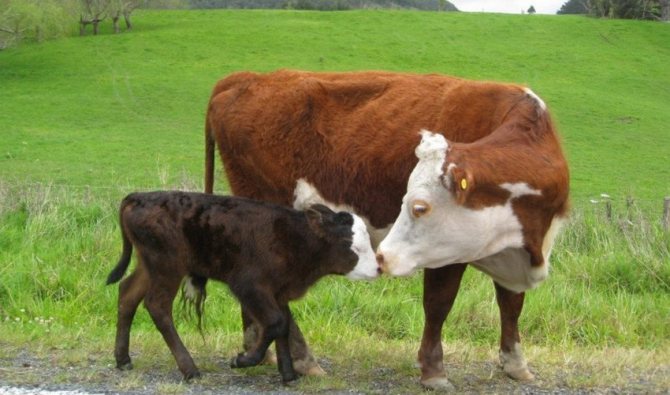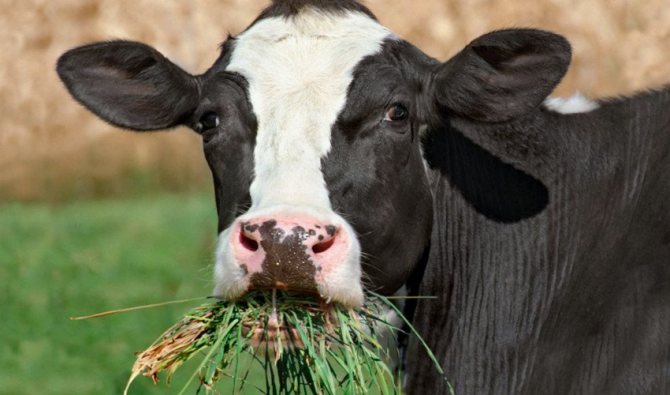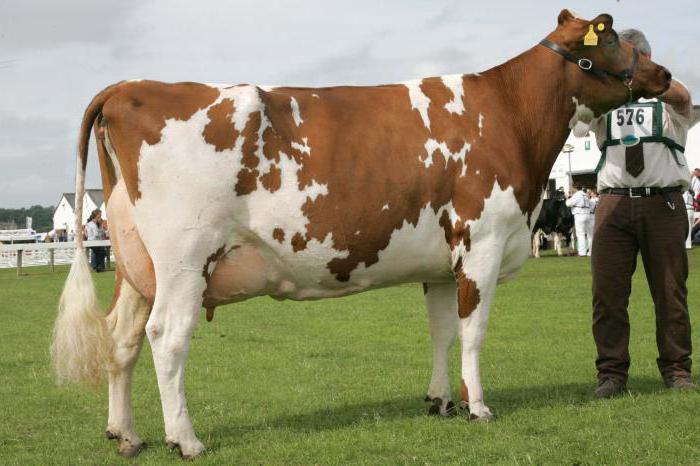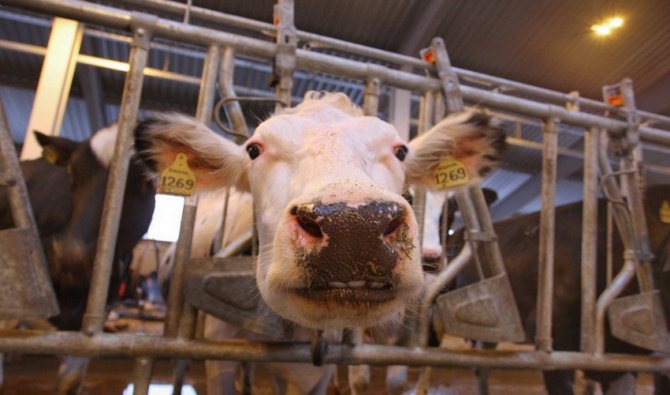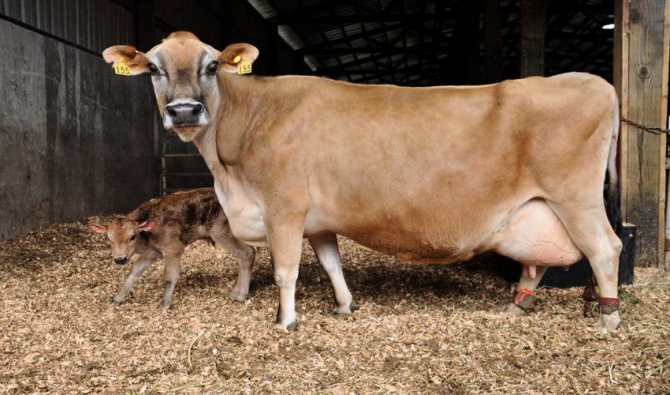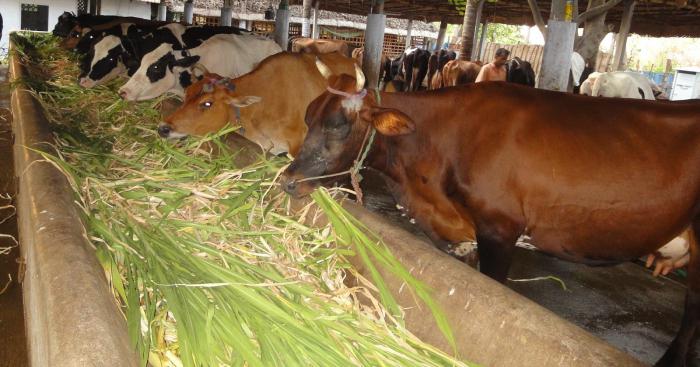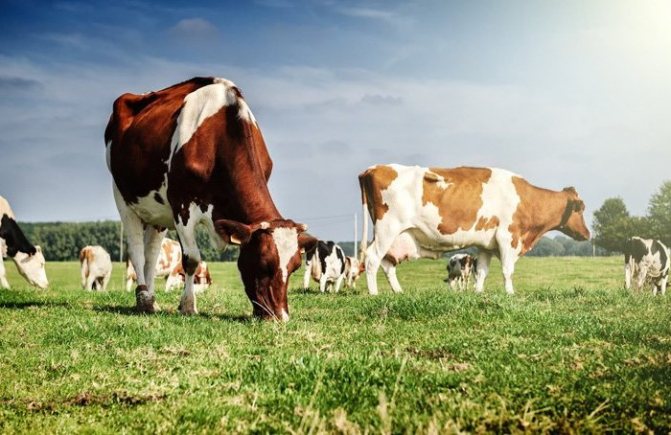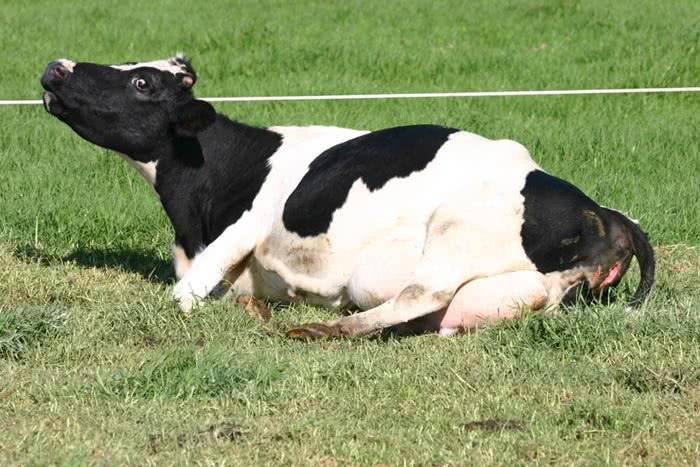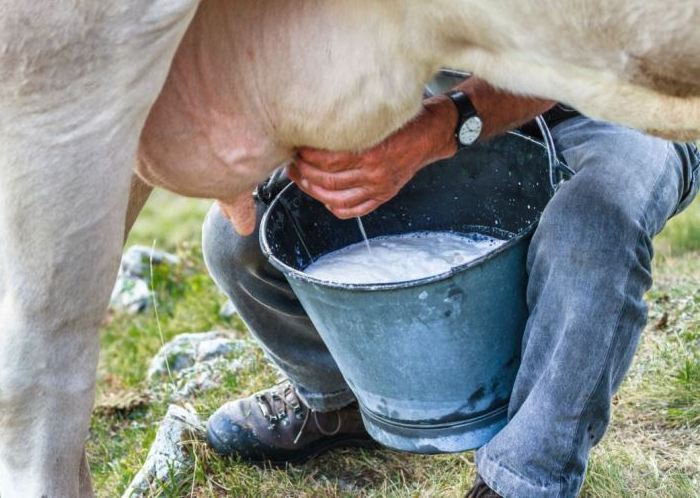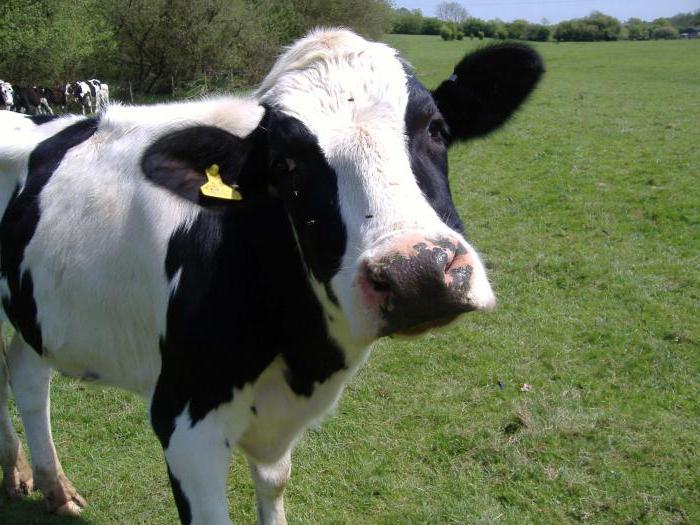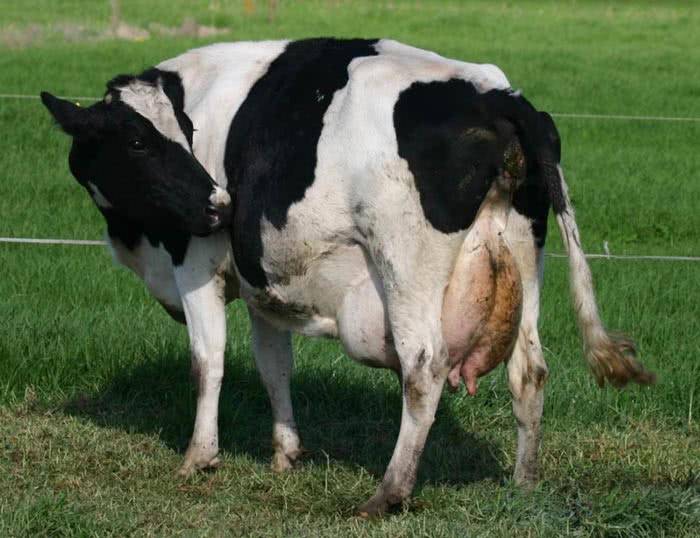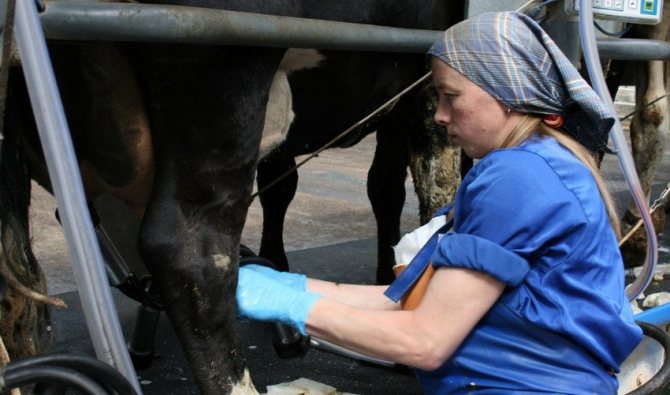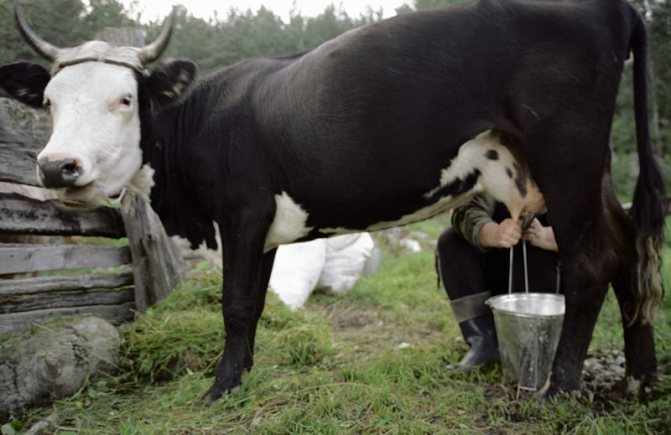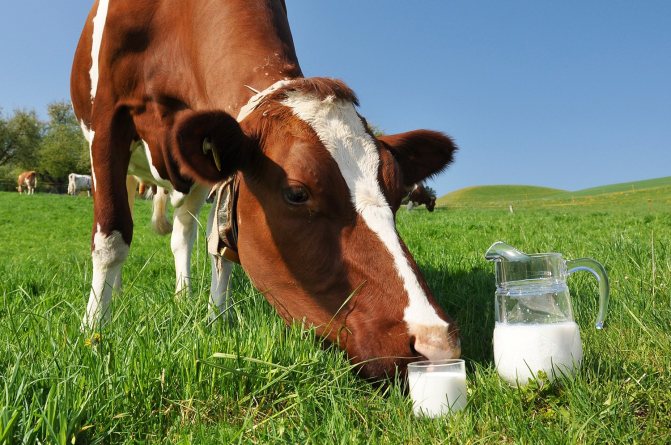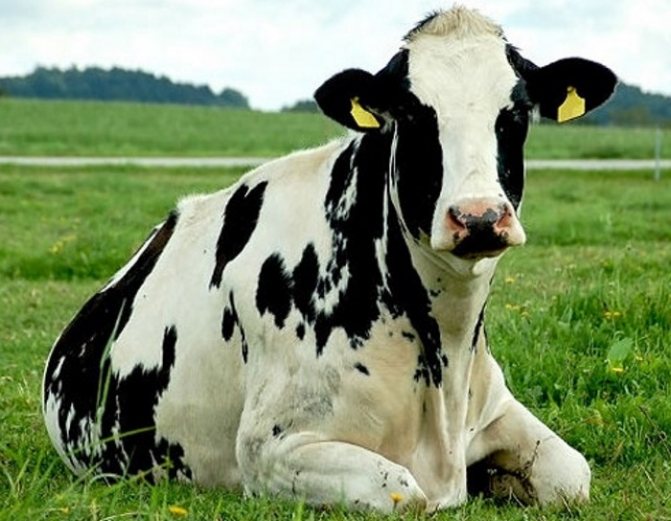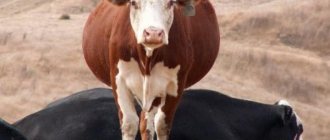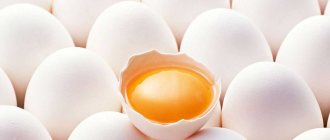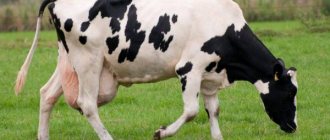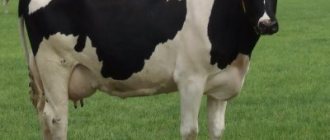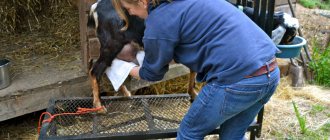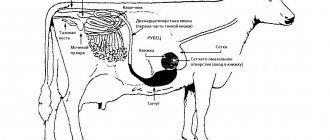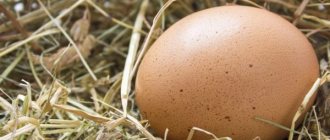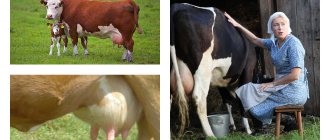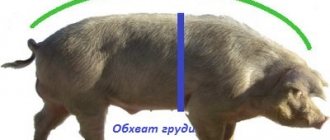Knowing how many liters of milk a cow gives per day is especially useful for novice farmers who are just about to purchase an animal. This will determine whether the purchase will be profitable and will help to rationally plan the consumption of dairy products. In addition, operating with such indicators will allow you to correctly assess the productivity of cows that are already on the farm, and take timely measures to increase milk yield.
Cow's milk
The role of age in productivity
Heifers start their first heat at the age of 8-10 months, but this does not mean that the animal is ready to mate.
How much milk a cow gives depends on the conditions of her keeping, nutritional value of the feed, age and breed. The time after calving should also be attributed to the productivity indicator, because the animal's body produces a product for raising offspring.
The cow's body is still at a developmental stage and is not capable of carrying a baby. The weight of a heifer, ready to bear offspring, should reach 70% of the body weight of an adult animal of this breed. The female reaches this weight on average in 2-3 years.
How and when does milk appear
Everyone knows what milk is. But not everyone knows when and why it appears. As with all mammals, cow's milk is intended for feeding the calf and appears immediately after calving. However, man has learned to make animals give this product almost constantly throughout the year. Even when the calf is gone.
The product that a cow gives immediately after calving has a unique composition, increased fat content and is called colostrum. It contains about 90 biological elements, including immunoglobulins, antiviral components and natural antibiotics. Colostrum is not very suitable for consumption, therefore it is used to feed the calf. Regular milking tricks the animal into thinking it is for the calf and continues to produce milk. Moreover, the productivity of the cow is gradually increasing. The maximum rates are observed at the end of the first or middle of the second month after calving.
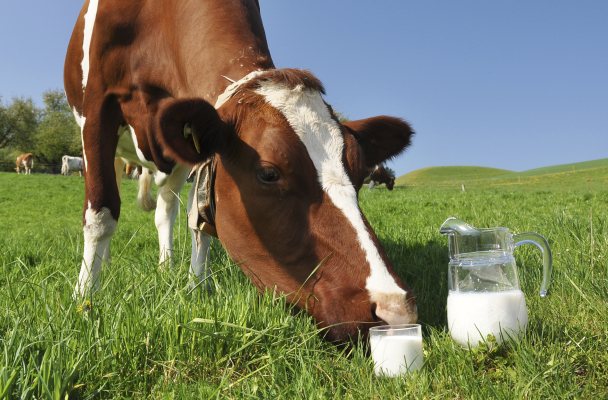
Dependence of milk yield on the breed
Above, the dependence of milk yield on many factors was noted, including belonging to a certain breed. And how many cows of different breeds give milk per day?
Referring to the average milk yield, it is possible to single out the Holstein breed among all breeds, the daily milk yield from which is 25-30 liters!
In accordance with the daily milk yield, further black-and-white (18-28 liters) and Ayshir (13-26 liters) breeds can be arranged.
Kholmogorsk (15-17 liters) and Yaroslavl (13-20 liters) cows are slightly behind in milk yield.
In the last place is the red steppe breed (11-13 liters).
In terms of annual milk yield, the Holstein and black-and-white cows are in first place (7.5-9 and 5.6-8.4 tonnes liters), in second place are the Ayshir and Yaroslavl breeds (4-8 and 4-6 tonnes liters), on the latter - Kholmogorsk and red steppe (4.5-5 and 3.5-4 tons of liters)
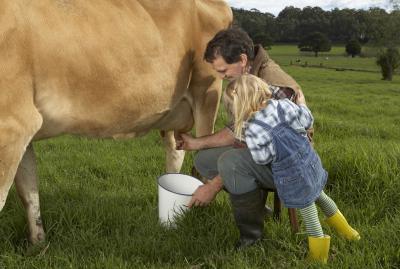

Average daily milk yield of common breeds
The daily milk yield depends on many factors, as noted earlier. But there is a certain period when lactation is at its peak.So how much milk does a cow give per day? The average milk yield (assuming the lactation period is 10 months) can be found in the table below.
| Breed | Daily milk yield, kg | Annual milk yield, t | Fat,% |
| Kholmogorskaya | 15-17 | 4,5-5 | 3,9 |
| Holstein | 25-30 | 7,5-9 | 3,8 |
| Black and motley | 18-28 | 5,6-8,6 | 2,5-3 |
| Red steppe | 11-13 | 3,5-4 | 3,5 |
| Yaroslavl | 13-20 | 4-6 | 4,15 |
| Ayshirskaya | 13-26 | 4-8 | 4,5 |
Between calving and the next pregnancy, milk production is higher than the average daily rate.
What determines the amount of milk
There is no definite answer to the question of how much milk a cow gives per day. Many factors affect milk production:
Breed. There are "meat" and "dairy" varieties of cows. Age. The more years a cow becomes, the more milk she begins to produce. Food.
Variety in the animal's diet has a beneficial effect on milk production. Health. Lactation begins to fade if the cow is sick. Therefore, you need to systematically show it to the veterinarian. Season.
If calving took place in the autumn-winter period, then milk production is 10% more than in the spring-summer.
The most suitable age for mating is 1.5–2 years. It is not advisable to do this very early, but it is also not recommended to delay it, so as not to decrease productivity. In the first days after the birth of the baby, the cow gives colostrum - this is a very valuable and healthy product for calves. Therefore, from the first days, you need to let the cub near the mother, it will be useful for him and for massage of the cow's udder, so that mastitis does not develop. If you do not immediately let the calf near the cow, then she may not allow the milkmaid to come to her.
What factors influence the amount of dairy products
The productivity of dairy cattle is at the genetic level and depends on the breed of the animal. The largest milk yield is obtained from dairy cows, representatives of the universal one give somewhat less, and very little is obtained from beef cattle. In such animals, milk is used only for feeding the young.
Personality also contributes to productivity. Much depends on the shape of the udder and the development of the circulatory system in a given organ. To produce a liter of product, about 500 liters of blood pass through the mammary glands. Age-related changes also affect the amount of milk - animals after the fourth calving give more milk than other animals.
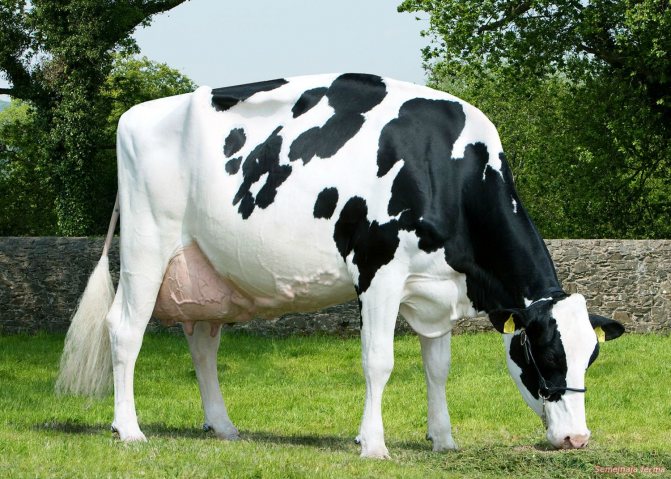

Dairy cow
Not the last role is assigned to the diet: it is the feed that provides the blood with the necessary substances and vitamins. A correct, balanced and varied diet has a direct impact on the taste of dairy products.
Of course, milk will be formed without feed, but its absence, just like a shortage, leads to a deterioration in the quality of products, and the milk yield itself also decreases. During the lactation period, the animals are given food according to the norms (in particular, this applies to the winter period).
Daily milk yield
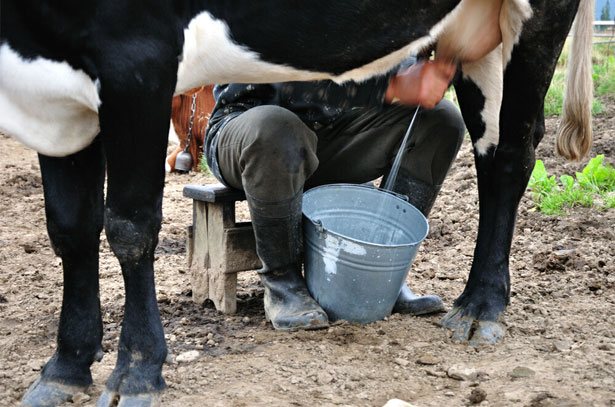

The daily milk yield from each cow is always higher between birth and the next pregnancy. A cow can produce 20 liters of milk or more per day. According to 2014 data, the average milk yield was 13.7 liters.
The best data was shown by the Leningrad region, the Republic of Karelia. At the same time in the Republic of Sakha we received a little more than 9 liters. It becomes clear that care and conditions of detention played a major role in this.
What is the reason for the lack of lactation
Very often, after calving, milking is done with errors, which leads to a decrease in milk yield or no milk at all. Natural mechanisms work in such a way that after the end of the sucking period, a decrease in the amount of dairy products begins. On farms, they try to prevent this manifestation, which is why milkings are made. Frequent milk intake shows the cow's body that the young need milk.
Rough handling, stressful situations, change of place, noise - all these factors have a negative impact on the amount of milk. This also includes the change of milking operators and the place where the process itself is carried out. Udder injuries to animals also affect milk production.
Violation of keeping conditions, the presence of drafts, cold air in the barn, lack of succulent feed in the ration - all this will not add the amount of milk to the cows.
The appearance of a salty taste in milk indicates age-related changes in the animal's body or the onset of estrus. If all of the above factors are not identified, and the cow still does not give milk, then you need to contact your veterinarian to find out the reasons and make a diagnosis.
Change in productivity
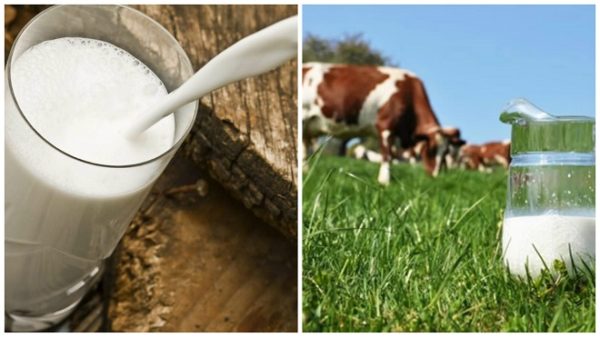

More often than not, when a cow begins to produce less milk, the owners of the animal are to blame... Excessive overflow of the udder leads to squeezing of blood vessels in it, and hence a sharp decrease in daily milk yield. To prevent this from happening, you need to milk the cow only at a strictly defined time, developing her reflex.
Also, with a decrease in indicators, it is recommended to increase the number of milkings from two to three times, which will free up space for the formation of new milk. Milking three times should also be practiced with spontaneous milk flow.
It is important every time to strain the udder to the last drop, since it is the lower milk that is the fattest, and when left, provokes the formation of mastitis. Milk residues also burn out, slowing down the production of subsequent milk.
Why are milk yield declining?
The problem of the loss or decrease in the amount of milk that a cow produces per day has the official name agalactia and hapogalactia, respectively. The first term means milklessness of the animal, and the second - low milkiness. Both one and the second phenomenon is a serious pathology that must be eliminated by a therapeutic method. The main thing is to understand what triggered the disease.
You may also be interested in information about what diseases the Jersey breed of cows may have.
There are the following reasons and types of milk loss in a cow:
- Fodder agalactia... Such a disease arises due to an improper diet of livestock. This applies to starvation, lack of vitamins and nutrients, low protein intake, poor quality feed, low water volume, as well as the poverty of food consumed. Separately, it should be noted that this problem also arises against the background of certain diseases of the gastrointestinal tract.
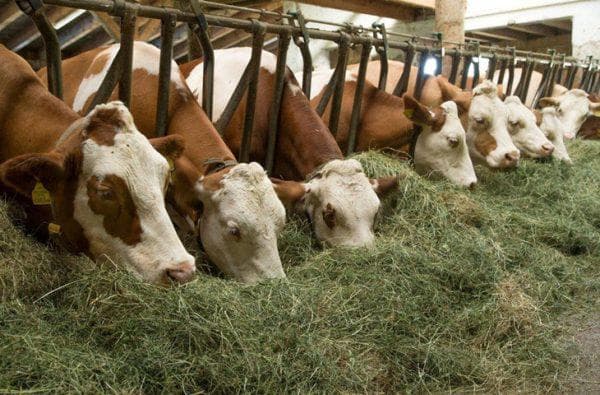

- Artificial agalactia... Such a disease manifests itself only against the background of any stressful and nervous situations. This happens when the cow changes conditioned reflexes, his habitat, owner or milking method change. The schedule and schedule also play a role in this process.
- Climatic agalactia. As the name implies, the reason for the loss of milk in this case is the poor climatic conditions of the animal. Too damp air, pollution, lack of proper ventilation, poor lighting, etc. can affect. For a long time, the cow should not be under the scorching sun or in adverse conditions. But at the same time, she should definitely go out and walk.
- Operational agalactia. This problem arises only through the fault of the livestock owner. He can make poor preparation for lactation, carry out too intensive milk production, provoke early calving, reduce or increase the number of milkings. Often, milking a cow fairly frequently in the first few months will lead to an increase in milk supply and, over time, to a sharp decrease.
- Physiological agalactia... In this case, the problem arises against the background of some kind of ailment.The most common among them are mastitis, inflammation of the udder, inflammation of the uterus, and food poisoning. It should be noted that each disease has its own distinctive features, which can be used to make a preliminary diagnosis. Full recovery of the body, including the production of the same volume of milk, occurs only after recovery.
Another significant cause that can affect the performance of a cow is stagnation.
And here is what the Simmental breed of cows looks like and how much milk it can give. specified here.
This occurs only in those animals that lie down most of the time, move little and are rather inactive. Some veterinarians attribute this reason to the climate group, but other experts believe that this behavior primarily depends on the care of livestock. Most often, a similar situation occurs during the winter period, when farmers do not walk their cows, although this should be done.
How much milk does a cow give per day
After the first calving, the productivity of the animal varies within 9 liters, after which it increases with each subsequent calving and reaches about 12 liters. But this cannot be considered the limit, because here the breed of first-calf heifers is important (for example, a Yaroslavl cow can produce up to 40 liters).
The highest daily milk yield is characteristic of cows that are 1-2 months of lactation. During this period, all organs of the cow work with increased activity. Maintaining milk activity allows adequate nutrition and technically correct milking. Once a month, a liter of product is taken to the laboratory for fat testing in order to formulate the correct diet.
Good feeding of the cow is one of the important factors in milk production, therefore, when it is received up to 10 liters, it is necessary to increase feeding, give vitamins and various supplements.
How to feed a cow so that milk is fatty
Experienced livestock breeders note that in order to obtain fat and good milk yield, it is important to provide the cow with a sufficient amount of coarse fiber. Hay should be 20% of the total dry feed. A decrease in roughage and an increase in concentrates will lead to a deterioration in milk, therefore it is important to respect their proportions.
Advice! You can increase the fat content of the product with the help of light carbohydrates and sugar. For this, it is recommended to give beets and carrots. Brewer's yeast, wheat bran, compound feed, premixes and silage also have a positive effect on the quality of milk.
In addition to nutrition, it is important to optimize the conditions for keeping cows. An increase in air temperature and humidity will reduce the fat content of the product, while coolness will increase it. Excessive nutrition can also negatively affect milk. It is important to regularly take the cows for a walk, even in winter, they should be outside the walls of the barn for several hours a day.
The milk yield of a cow largely depends on its breed. You can increase milk yield with a balanced diet rich in fiber, vitamins and minerals. Also, performance depends a lot on care. Responsible and tidy owners produce more milk. If the milk yield of the cow has decreased, it needs to be shown to the veterinarian, it is possible that diseases are developing, due to which lactation may stop altogether.
How to choose a dairy cow
Now you know how much milk a cow gives per day. In order for the volumes of the product to tirelessly delight and surprise you, you need to take a responsible approach to the choice of an animal.
Pay attention to the following characteristics:
- Udder: A cow with a large udder is more productive. Also a plus will be clearly visible thick and large veins.
- Legs. The legs of the animal must be strong. Before buying, walk a little forward with the cow. The gait should be confident, firm, and the legs should be straight.
- Chest.It should be wide and deep. It is unacceptable that it be lowered 10-15 cm below the elbow.
- Belly. Make sure that the belly of the cow is not saggy. This speaks of improper care of the animal.
- Ribs. The distance between them indicates the state of the respiratory system. If the ribs are close together, this means that the cow has small and poorly developed lungs.
- Head. The shape of the skull of a good dairy cow should be elongated. It is also desirable that the horns of the animal are small and thin.
- Tail. Its base should be thin. If the tail has a wide base, then this indicates a rough constitution of the animal. Age is of great importance. Do not take an overly adult cow.
After 8-9 calving, the cow's productivity is significantly reduced. Therefore, the indicator (how much milk a cow gives per day) will differ significantly from the average.
Main breeds of cows
Dairy cows produce larger volumes than beef cows. How much milk does an Ayrshire cow give per day? Its volume is incomparable with the productivity of the Hereford breed. There are three types of cows:
- Meat.
- Dairy.
- Meat and dairy.
There are a lot of dairy breeds of cows. These chicks are relentlessly setting records for milk production. The most popular ones are:
- Kholmogory breed. Individuals of this species are distinguished by developed muscles and a strong and powerful skeleton. The color of the animal is brown with large black spots, the shape of the skull is narrow. Its weight is about 500 kg. Annual milk production ranges from 4 to 5 tons.
- Holstein breed. This type of cattle is native to the Netherlands. Individuals of this species are characterized by the presence of a large udder, which indicates the production of large volumes of milk. The weight of an adult animal is about 700 kg. This breed is rightfully considered the record holder in terms of annual product output. In 1985, a twenty-year-old cow produced 211 tons per year. 570 liters - that's how much milk a cow gives per day at a record rate.
- Black and white breed. She is originally from the USSR. Until now, it is popular in the CIS countries. The weight of an adult cow is 400 kg. The skeleton of an individual is strong enough. The cow feels great in the temperate zone.
- Red steppe cow. Representatives of this breed can be seen on the territory of Ukraine. They are unpretentious and do not require special care. They can produce about 4 tons of milk per year. The weight of an adult is 400-500 kg. But their physique is light. And the skeleton cannot be called strong.
- Yaroslavl breed. These chicks are wildly popular in Russia. Their uniqueness is that they eat poorly. But milk production is more than impressive. One individual gives about 6 tons of milk per year. Most often they are black, sometimes with a red tint. The weight of the animal reaches 500 kg.
- Ayshir breed. She is originally from Scotland. The color of the animal is red and motley, and the average weight is 450 kg. These individuals are distinguished by a thin skeletal system and flexible joints.
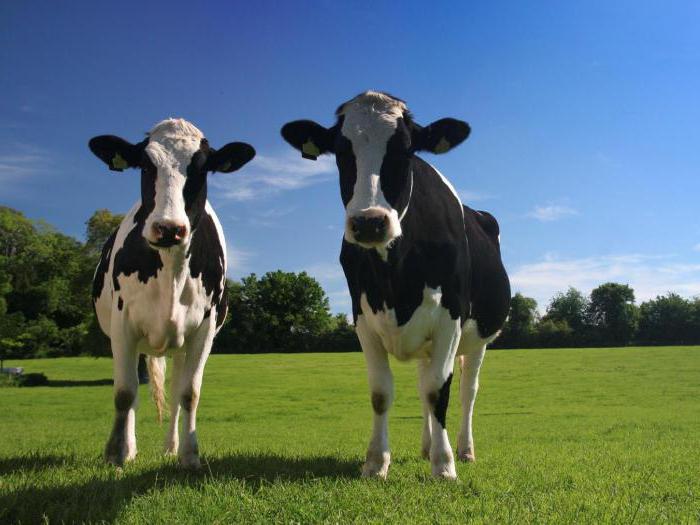

Milk formation process
It is possible to understand where milk comes from only after a detailed study of this complex and important process. It is formed in the mammary gland, which is called the udder.
As soon as the cow's body receives a signal about the need to provide the offspring with food, the process of secretion of the hormone prolactin starts. It is he who is responsible for the complete formation of colostrum, and in the future - milk. Its chemical composition, as well as its fat content, are associated with the production of thyroid hormones.
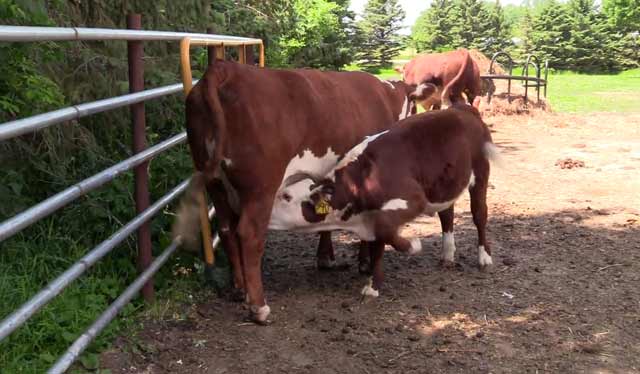

It is believed that higher milk yield cows have less fatty milk than average cows.
In the wild, mammals independently wean their young from the udder. As soon as the animal becomes pregnant, the mechanism of preparation for the appearance of a new baby is launched.As for personal farms, here a cow can produce milk for up to 300 days a year. A few months after calving, the cow has a decrease in lactation.
How to increase milk yield
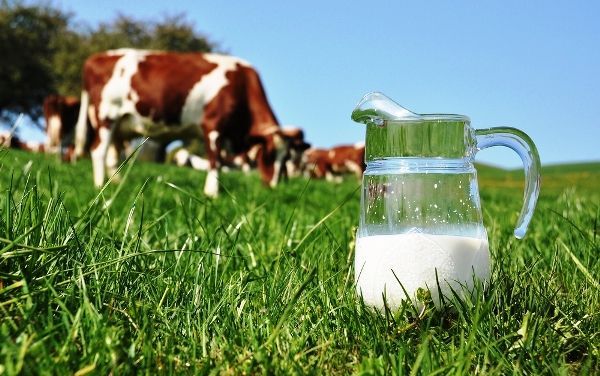

Let's now find out how you can increase the milk yield of a cow.
It is important that the animal is absolutely healthy and vaccinated, and lives in comfortable conditions. In the barn, you need to maintain the temperature regime recommended for the particular breed. Food should be balanced, satisfying, including all the necessary nutrients.
The animal must be treated tenderly and carefully - cows are very sensitive. It is important to follow the rules of milking: in particular, it is recommended to do this at least three times a day. Before starting milking, be sure to massage the udder.
Additional lighting will help to increase milk yield in autumn and winter. If the daylight hours are 18 hours, this will help to increase milk production by 10%. At the same time, too bright light can cause stress, so its intensity should not exceed 20 units.
Cow after calving
Once the heifer has given birth, she is allowed to lie down and rest for 40 minutes. During this period, her uterus will have time to cleanse, the afterbirth will be rejected, the animal will regain strength.
To support the woman in labor, 30 minutes after delivery, she is given a slightly saline solution.
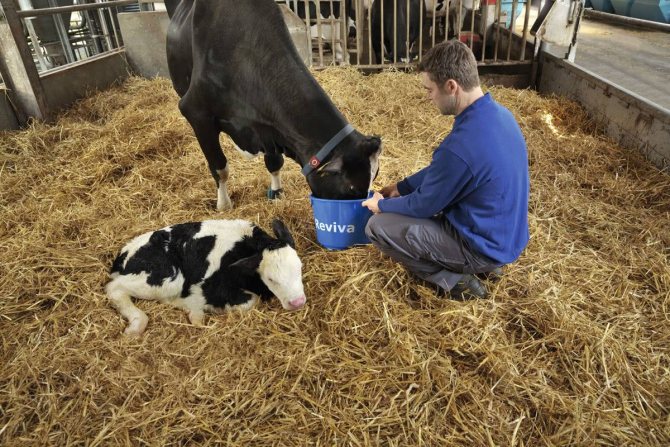

A little later, when the afterbirth leaves, the litter is changed under the cow and the first milking is performed. It should not be forgotten that the udder should always be washed before milking, and the nipples should be massaged before pumping. The first milk (colostrum) is immediately given to the calf.
It is more difficult to milk a cow, which is a firstborn, than a cow that has already given birth. We will have to increase the frequency of milking, which will have a positive effect on its milk production in the future. After calving, much attention is paid to the diet of the cow. What is its peculiarity? There are four points to follow:
- The animal is given the required amount of silage (it will immediately start the milk production process).
- On the second day, the cow is fed with bran (or rice). The diet includes 1 kg of bran, pre-soaked in water. On the following days, the amount of bran is increased and brought to 2 kg per day.
- On the 4th day, root vegetables are added to the food (they stimulate lactation).
- On the 8th day, the cow's nutrition should be made complete and everything that the cow ate before should be introduced into the diet.

